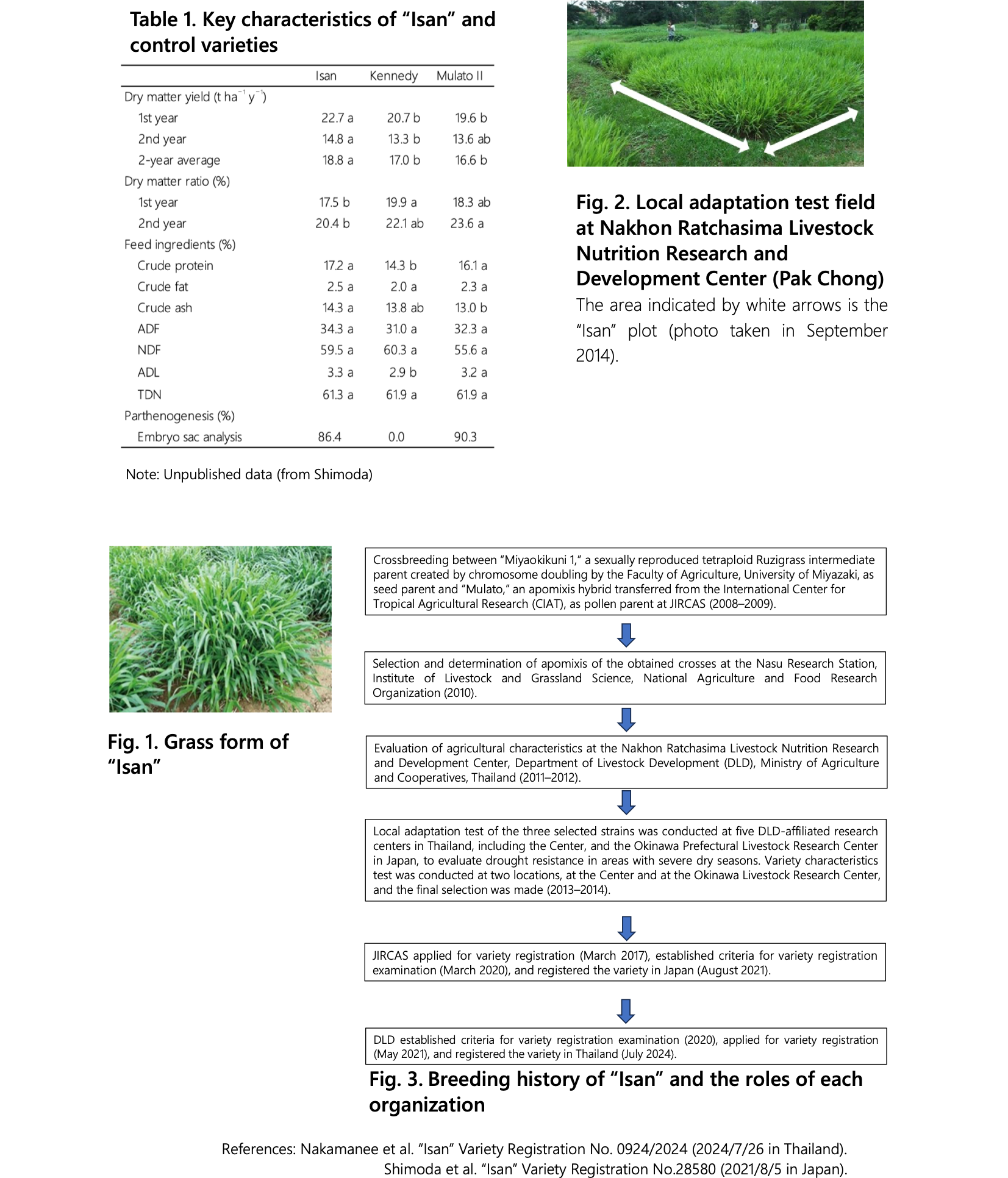Scalable Research Achievement
Breeding and variety registration of “Isan,” the first Urochloa grass variety for the Asian monsoon
Description
Urochloa (formerly known as Brachiaria) is a tropical grass widely grown in tropical and subtropical regions of the world. It has excellent forage characteristics such as high yield, strong drought resistance, aptitude for grazing, and high crude protein content. However, the breeding of Urochloa has been limited, only about 20 varieties have been registered in the world, most of which were bred in South America and Australia, and no varieties have been bred for the Asian monsoon region. On the other hand, beef and milk production is increasing in this region, and livestock farmers are under pressure to develop efficient feed production technology. Therefore, we will breed and develop tropical grass varieties that are suitable for the Asian monsoon climate and can be cultivated at a low cost with high yield and high quality.
“Isan” is the first variety of Urochloa pasture grass in Japan and Thailand (Figs. 1 and 2). Figure 3 shows the background of the breeding process and the roles of each organization. It has an average dry matter yield of 18.8 t ha-1 per year, about 12% higher than the average of 16.8 t ha-1 of existing varieties (Table 1). The dry matter ratio is about 2% lower than that of the existing varieties. It has excellent crude protein content, about 3% higher than the existing variety “Kennedy” at 17.2% in the first crop of the first year, and the TDN (Total Digestible Nutrients) content is similar to the existing variety. It can be easily established as a highly uniform pasture from seed due to apomixis.
“Isan” is distinguished by its high yield, high quality, and easy management, and has high potential to meet the needs of pasture grasses in the Asian monsoon region. In the frost-free zone of the Nansei Islands in Japan, it can be used as permanent grazing pasture or meadow. Because of its high crude protein content and suitability for rough grazing, it is expected to help farmers stabilize their business by reducing the need to purchase concentrate feeds, which are becoming increasingly expensive. The high summer temperatures in recent years have caused summer depression of temperate grasses. It is resistant to high temperatures and drought, and can reproduce by seed, so it is expected to be used in pastures from Kyushu to the Kanto region for a single year. Pre-drying is required to adjust moisture content to 60-70% for silage preparation due to its low dry matter content.
Figure, table
- Research project
- Program name
- Term of research
-
FY2006-2024
- Responsible researcher
-
Shimoda Katsuhisa ( Institute of Livestock and Grassland Science, NARO )
KAKEN Researcher No.: 60462537Ando Shotaro ( Research Planning and Partnership Division )
KAKEN Researcher No.: 00370578Ebina Masumi ( Institute of Livestock and Grassland Science, NARO )
Kouki Kaori ( Okinawa Prefectural Livestock and Grassland Research Center )
Akashi Ryo ( University of Miyazaki )
KAKEN Researcher No.: 20253809Suenaga Kazuhiro ( Biological Resources and Post-harvest Division )
MIERUKA ID: 001799Ando Sada ( Institute of Livestock and Grassland Science, NARO )
KAKEN Researcher No.: 40502943Kanamori Norihito ( Information and Public Relations Office )
Naruo Matsumoto ( Information and Public Relations Office )
Nakamanee Ganda ( Department of Livestock Development, Thailand )
Rimkeeree Kamol ( Department of Livestock Development, Thailand )
Srisompom Wattanawan ( Department of Livestock Development, Thailand )
Patipan Chalermpon ( Department of Livestock Development, Thailand )
Mangpung Yaowalak ( Department of Livestock Development, Thailand )
- ほか
- Publication, etc.
-
Shimoda et al.「ISAN」Variety Registration No. 28580 (2021/8/5 in Japan)Nakamanee et al. 「Isan」 Variety Registration No. 0924/2024 (2024/7/26 in Thailand)Ebina et al. (2021) Kanto journal of animal science 71: 2−10
- Japanese PDF
-
2024_C03_ja.pdf1015.77 KB
- English PDF
-
2024_C03_en.pdf610.47 KB
* Affiliation at the time of implementation of the study.

